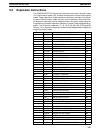
140
5-4 Differentiated Instructions
Most instructions are provided in both differentiated and non-differentiated
forms. Differentiated instructions are distinguished by an @ in front of the
instruction mnemonic.
A non-differentiated instruction is executed each time it is cycled as long as its
execution condition is ON. A differentiated instruction is executed only once af-
ter its execution condition goes from OFF to ON. If the execution condition has
not changed or has changed from ON to OFF since the last time the instruction
was cycled, the instruction will not be executed. The following two examples
show how this works with MOV(21) and @MOV(21), which are used to move the
data in the address designated by the first operand to the address designated by
the second operand.
00000
MOV(21)
HR 10
DM 0000
Diagram A
00000
@MOV(21)
HR 10
DM 0000
Diagram B
Address Instruction Operands
Address Instruction Operands
00000 LD 00000
00001 MOV(21)
HR 10
DM 0000
00000 LD 00000
00001 @MOV(21)
HR 10
DM 0000
In diagram A, the non-differentiated MOV(21) will move the content of HR 10 to
DM 0000 whenever it is cycled with 00000. If the cycle time is 80 ms and 00000
remains ON for 2.0 seconds, this move operation will be performed 25 times and
only the last value moved to DM 0000 will be preserved there.
In diagram B, the differentiated @MOV(21) will move the content of HR 10 to DM
0000 only once after 00000 goes ON. Even if 00000 remains ON for 2.0 seconds
with the same 80 ms cycle time, the move operation will be executed only once
during the first cycle in which 00000 has changed from OFF to ON. Because the
content of HR 10 could very well change during the 2 seconds while 00000 is
ON, the final content of DM 0000 after the 2 seconds could be different depend-
ing on whether MOV(21) or @MOV(21) was used.
All operands, ladder diagram symbols, and other specifications for instructions
are the same regardless of whether the differentiated or non-differentiated form
of an instruction is used. When inputting, the same function codes are also used,
but NOT is input after the function code to designate the differentiated form of an
instruction. Most, but not all, instructions have differentiated forms.
Refer to 5-10 INTERLOCK and INTERLOCK CLEAR – IL(02) and IL(03) for the
effects of interlocks on differentiated instructions.
The C200HX/HG/HE PCs also provide differentiation instructions: DIFU(13)
and DIFD(14). DIFU(13) operates the same as a differentiated instruction, but is
used to turn ON a bit for one cycle. DIFD(14) also turns ON a bit for one cycle, but
does it when the execution condition has changed from ON to OFF. Refer to
5-9-2 DIFFERENTIATE UP and DOWN - DIFU(13) and DIFD(14) for details.
Note Do not use SR 25313 and SR 25315 for differentiated instructions. These bits
never change status and will not trigger differentiated instructions.
Differentiated Instructions Section 5-4


















